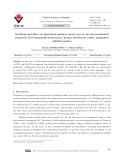
The electropolymerization
-
In the literature, there are some studies on the synthesis of heteroaryl and allylindoles by Stille cross-coupling reactions that offer advantages to the Suzuki reactions in view of the neutral conditions and the stability and accessibility of the tin derivatives. Previously, we have also synthesized 5-(2-thienyl) indole (5In-2Th) comonomer [39] and Th-, Cz-, and thiazole-based monomers by using Stille cross coupling reaction [37, 40, 41].
 17p
17p  lyhuyenthu
lyhuyenthu
 31-01-2023
31-01-2023
 13
13
 3
3
 Download
Download
-
The PANI/nc-TiO2 heterojunctions were formed in the composite films due to the insertion of PANI in nano-porous TiO2 particles. PANI/ITO films exhibited a reversible electrochromic display (ECD) performance when cycled in 0.1M LiClO4 + propylene carbonate
 7p
7p  meyerowitz
meyerowitz
 25-12-2021
25-12-2021
 6
6
 0
0
 Download
Download
-
For the first time a molecularly imprinted polymer (MIP)-based sensor for tyrosinase is described. This sensor is based on the electropolymerization of scopoletin or o-phenylenediamine in the presence of tyrosinase from mushrooms, which has a high homology to the human enzyme. The template was removed either by treatment with proteinase K or by alkaline treatment. The measuring signal was generated either by measuring the formation of a product by the target enzyme or by evaluation of the permeability of the redox marker ferricyanide.
 9p
9p  tudichquannguyet
tudichquannguyet
 29-11-2021
29-11-2021
 11
11
 2
2
 Download
Download
-
In this work, 4-(3-morpholin-4-ylpropoxy)phthalonitrile 2, 3-(3-morpholin-4-ylpropoxy)phthalonitrile 3, Co(II)Pc and Mn(III)Pcs containing (3-morpholin-4-ylpropoxy) groups at peripheral and nonperipheral positions were synthesized. Phthalonitrile derivatives (2 and 3), Co(II)Pc and Mn(III)Pcs (2a, 2b, 3a, 3b) were characterized by using FT-IR, NMR (only for 2 and 3), mass and UV–Vis (except 2 and 3) spectral data techniques. Also, electrochemistry of (3-morpholin-4-ylpropoxy) group substituted Co(II)Pc and Mn(III)Pcs were inspected by using cyclic voltammetry.
 8p
8p  tudichquannguyet
tudichquannguyet
 29-11-2021
29-11-2021
 8
8
 1
1
 Download
Download
-
3-[5-(diethylamino)-2-formylphenoxy]phthalonitrile (n-TY-CN), metallophthalocyanines n-TY-Co, n-TY-Cu, and n-TY-Mn bearing [5-(diethylamino)-2-formylphenoxy] groups at nonperipheral positions were prepared for the first time. These compounds were characterized with IR, NMR (only for n-TY-CN), mass and UV-vis (except n-TY-CN) spectroscopy.
 17p
17p  tudichquannguyet
tudichquannguyet
 29-11-2021
29-11-2021
 5
5
 0
0
 Download
Download
-
This study reports a detailed analysis of an electrode material containing poly(phenolphthalein), carbon nanotubes and gold nanoparticles which shows superior catalytic effect towards to hydrazine oxidation in Britton–Robinson buffer (pH 10.0). Glassy carbon electrode was modified by electropolymerization of phenolphthalein (PP) monomer (poly(PP)/GCE) and the multiwalled carbon nanotubes (MWCNTs) was dropped on the surface. This modified surface was electrodeposited with gold nanoparticles (AuNPs/CNT/poly(PP)/GCE).
 21p
21p  tudichquannguyet
tudichquannguyet
 29-11-2021
29-11-2021
 10
10
 0
0
 Download
Download
-
Characteristic UV–vis and Raman bands were identified and their dependencies on the electrode potential have been discussed. Spectroelectrochemical results reveal differences both in the position of the spectral bands and their potential dependence for PPy and P(Py--DMCD) films indicating interactions between polymer chains and CDs during electropolymerization process. The films were also characterized by cyclic voltammetry and FT-IR spectroscopy.
 6p
6p  tamynhan8
tamynhan8
 04-11-2020
04-11-2020
 8
8
 1
1
 Download
Download
-
Poly 1-amino-9,10-anthraquinone (PAAQ) films were prepared by the electropolymerization of 1-amino-9,10-anthraquinone (AAQ) on platinum substrate from aqueous media, where 5.0 • 103 mol L1 AAQ and 6.0 mol L1 H2SO4 were used. The kinetics of the electropolymerization process was investigated by determining the change of the charge consumed during the polymerization process with time at different concentrations of both monomer and electrolyte. The results have shown that the process follows first order kinetics with respect to the monomer concentration.
 8p
8p  kethamoi1
kethamoi1
 17-11-2019
17-11-2019
 23
23
 0
0
 Download
Download
-
The electrooxidation of 5-hydroxy-1,4-naphthoquinone (JUG) in organic media leads to conducting polymer film on glassy and Pt electrodes. The IR ex situ, IR in situ (MIRFTIRS) during the film formation, XPS studies indicate that electropolymerization occurs via the OH group while quinone group on the other ring remains intact and shows a very good electro activity and stability in different media, particularly in aqueous, biocompatible one.
 5p
5p  uocvong03
uocvong03
 24-09-2015
24-09-2015
 51
51
 2
2
 Download
Download
-
In recent years, great focus has been placed upon polymer thin films. These polymer thin films are important in many technological applications, ranging from coatings and adhesives to organic electronic devices, including sensors and detectors. Polymers can be prepared using chemical and/or electrochemical methods of polymerization. There are a few advantages of electrosynthesis over chemical methods.
 226p
226p  cucdai_1
cucdai_1
 14-10-2012
14-10-2012
 88
88
 18
18
 Download
Download
-
are not limited to: the wide range of oxidation and reduction reactions possible, the possibility of reaching very high levels of product purity and selectivity, and significantly less energy requirement. The process of electropolymerization leads to simple and reproducible formations of polymer films, which led to a broad material diversity of applications. Nowadays, electrochemistry plays an important role in a wide number of fundamental research and applied areas.
 226p
226p  lulanphuong
lulanphuong
 22-03-2012
22-03-2012
 114
114
 20
20
 Download
Download
CHỦ ĐỀ BẠN MUỐN TÌM












![Synthesis of nonperipherally tetra-[5-(diethylamino)-2-formylphenoxy] substituted metallophthalocyanines and their electrochemistry Synthesis of nonperipherally tetra-[5-(diethylamino)-2-formylphenoxy] substituted metallophthalocyanines and their electrochemistry](https://tailieu.vn/image/document/thumbnail/2021/20211129/tudichquannguyet/135x160/961638155266.jpg)










